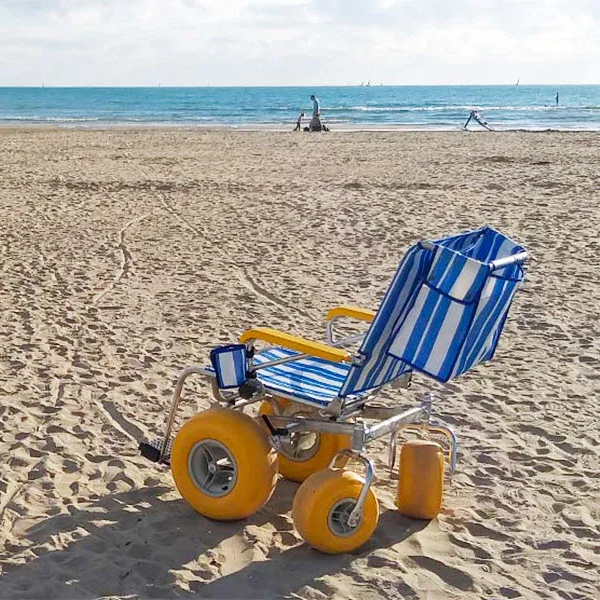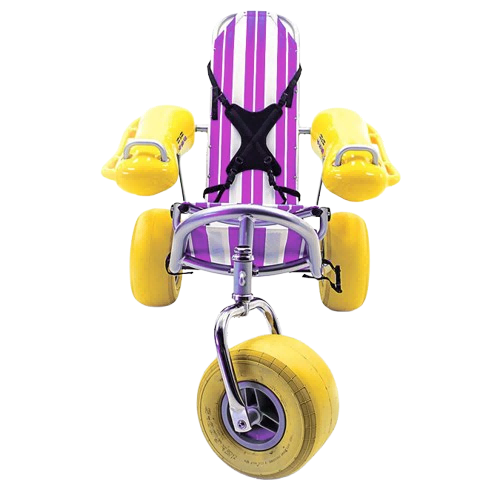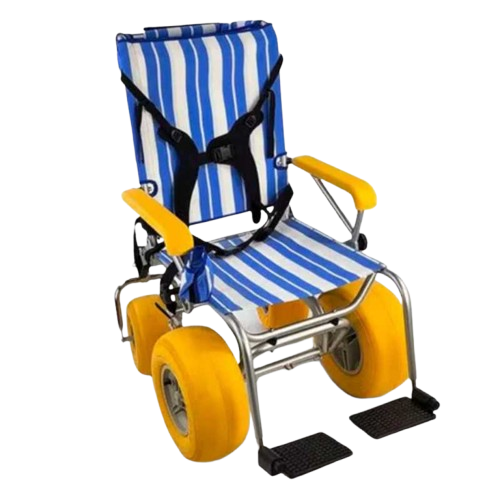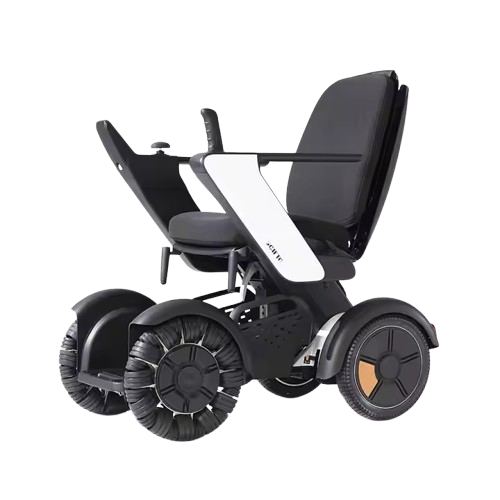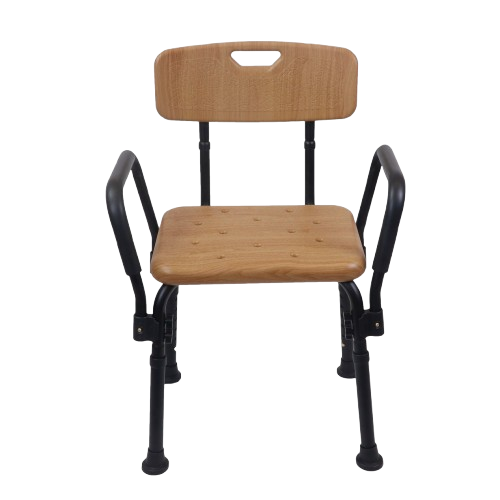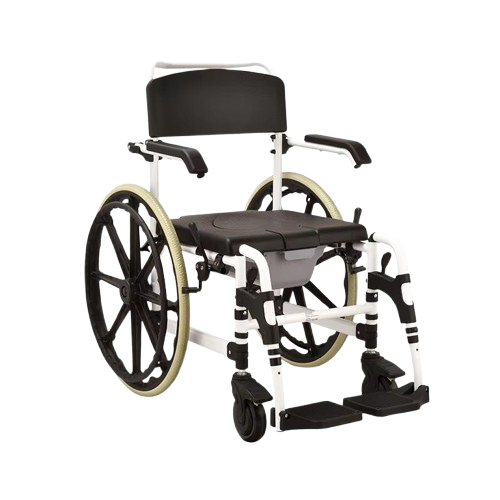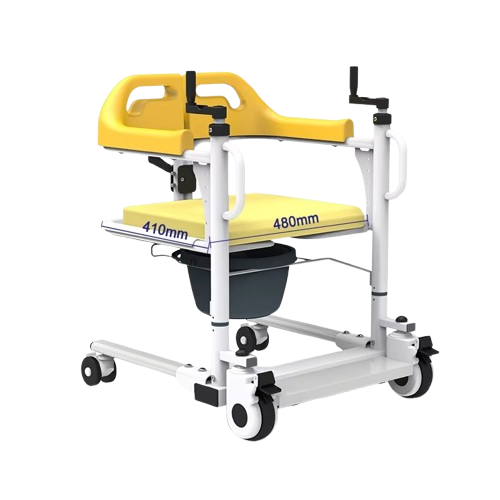Introduction

Imagine the sun warming your skin, the rhythmic crash of waves soothing your soul, and the salty breeze whispering freedom into your ears. The beach beckons, promising an escape from the everyday grind. But if you use a wheelchair, that dream can feel just out of reach. Not anymore. Beach wheelchairs are revolutionizing coastal adventures, allowing everyone to feel the sand beneath their wheels and the surf brushing against their feet.
Whether you’re a seasoned beachgoer or planning your first seaside adventure, the right tips and techniques can turn a simple outing into an unforgettable experience. From navigating shifting sands to picking the perfect wheelchair, we’ve gathered the most practical and innovative advice to ensure your beach day is as smooth as a wave gliding to shore.
Get ready to unlock the beach’s hidden treasures—without limits. Embrace the adventure with confidence, armed with expert tips that will transform your beach wheelchair experience. Ready to roll into your best beach day yet? Let’s dive in!
Choosing the Right Beach Wheelchair
When it comes to beach adventures, not all wheelchairs are created equal. Picking the right one can make or break your day in the sun. With so many options out there, it’s essential to find a beach wheelchair that matches your needs and lifestyle. Let’s break down what to look for so you can hit the sand with confidence.
Types of Beach Wheelchairs: Manual vs. Electric
The first decision you’ll need to make is whether to go manual or electric. Manual beach wheelchairs are typically lightweight and easier to transport, making them perfect for short trips or locations without power sources. They often come with large, balloon-like wheels that glide effortlessly over sand. Plus, they give you the flexibility to move independently or with assistance.
Electric beach wheelchairs, on the other hand, offer unparalleled mobility. They’re built for longer excursions and rugged terrain, effortlessly tackling soft sand and inclines. Some models even come with all-terrain tires and enhanced suspension for extra stability. The downside? They’re heavier and require charging, so make sure you plan ahead.
Features to Look For
Choosing the right wheelchair is all about the details. Here are a few must-have features to consider:
- All-Terrain Wheels: Look for large, pneumatic or balloon wheels that can roll over sand without sinking.
- Corrosion-Resistant Frame: Saltwater can wreak havoc on metal parts, so opt for rust-proof materials like aluminum or stainless steel.
- Adjustable Seating: Comfort is key, especially for long beach days. Make sure the seat can tilt or recline to relieve pressure points.
- Safety Belts and Support: Rough terrain can lead to jostling, so secure seating is crucial for stability and safety.
- Storage Options: A built-in basket or pouch can hold essentials like sunscreen, snacks, and personal items.
Renting vs. Buying
Should you rent or buy? It depends on how often you plan to hit the beach. If beach outings are a rare treat, renting from a local service can save you money and maintenance hassle. Many coastal towns have rental shops with various models available, so you can test different types before committing.
If beach days are a regular part of your life, investing in your own beach wheelchair makes sense. You’ll always have a chair that suits your needs without worrying about availability or rental fees. Plus, you can customize it with accessories to make it truly your own.
Finding Reliable Suppliers and Rental Services
Not all rental services are created equal. Check online reviews and ask for recommendations from local beach accessibility groups. Make sure the rental includes maintenance and support, just in case you hit a snag during your day out. Look for businesses that offer delivery and pickup, so you don’t have to worry about transport logistics.
With the right beach wheelchair, you’ll be prepared to embrace the sun, sand, and surf without limitations. Next up: how to prepare for your ultimate beach adventure—packing tips, weather checks, and more!
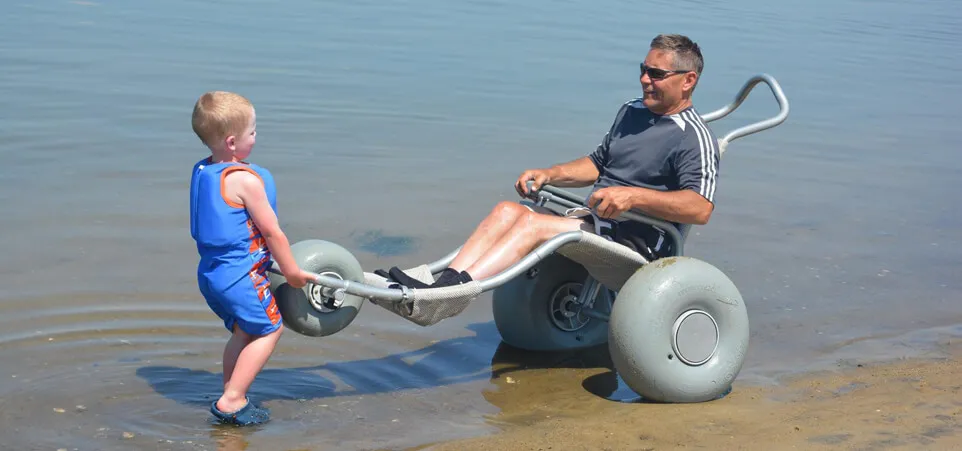
Preparing for Your Beach Adventure
Once you’ve got the perfect beach wheelchair sorted, it’s time to plan for an unforgettable day on the sand. A little preparation goes a long way in making sure everything runs smoothly. From checking the weather to packing the right gear, follow these tips to get ready for the ultimate beach experience.
Check the Weather and Tidal Conditions
Before you head out, always check the weather forecast and tidal charts. A sunny day with mild tides is ideal, but unpredictable weather can quickly turn a fun outing into a challenge. Use reliable apps like Windy or AccuWeather to get real-time updates.
Pay attention to the wind speed and direction, as strong gusts can make wheelchair maneuvering difficult. Likewise, high tide can swallow up your favorite spot, so aim to arrive during low or mid-tide for the best access and safety.
Essential Accessories to Pack
Packing wisely can make or break your beach day. Here’s a checklist of must-have accessories to ensure comfort and convenience:
- Sunshade or Beach Umbrella: Keep cool and protect your skin from harsh UV rays.
- Cushions and Seat Pads: Long periods of sitting on uneven surfaces can get uncomfortable. Invest in water-resistant cushions for extra support.
- Sunscreen and Lip Balm: Opt for reef-safe, high-SPF formulas to shield your skin.
- Waterproof Bags: Store electronics, snacks, and personal items securely.
- Cooling Towels and Fans: Stay refreshed during hot summer days.
- Repair Kit: Just in case—include tire patches, a multi-tool, and any essential wheelchair parts.
- First Aid Kit: Be prepared for minor scrapes or injuries.
Pre-Trip Maintenance Tips
Your beach wheelchair is your ticket to freedom on the sand—don’t let maintenance issues hold you back. Follow these pre-trip checks to avoid unexpected hiccups:
- Check Tire Pressure: Low pressure can make maneuvering tough. Inflate to the recommended PSI.
- Inspect the Frame: Look for signs of rust, cracks, or loose bolts.
- Charge Your Battery (for Electric Models): Make sure it’s fully juiced before heading out.
- Test the Brakes: Sand can cause them to jam, so ensure they’re functioning smoothly.
- Pack a Spare Battery or Charger: If you’re planning a full day at the beach, having backup power is a game-changer.
Creating a Packing Checklist
Forget something once, and you’ll never make that mistake again! Keep this quick checklist handy to streamline your packing process:
- Personal Identification and Medical Info
- Water Bottles and Hydration Gear
- Snacks and Easy-to-Eat Meals
- Towels and Extra Clothes
- Entertainment (Books, Bluetooth Speaker)
- Cleaning Supplies (Disinfectant Wipes, Hand Sanitizer)
- Mobile Phone and Power Bank
- Beach Permit (if required)
- Camera to Capture Unforgettable Moments
- Trash Bags to Keep the Beach Clean
Plan Your Route and Accessibility
Beach accessibility can vary widely, so research the area beforehand. Look for beaches with accessible paths, ramps, and dedicated wheelchair-friendly zones. Check local government websites or apps like WheelMate for accurate information on accessibility features.
Let friends or family know your plans and estimated return time. Sharing your location via a tracking app can also add an extra layer of safety.
By planning ahead and packing smart, you’ll set yourself up for a stress-free and enjoyable beach adventure. Ready to tackle the sand? Let’s dive into the best techniques for navigating different terrains in the next section!
Navigating Different Beach Terrains
Beaches are beautiful, but they can also be unpredictable. From soft, shifting sands to wet, compacted areas near the water, navigating various terrains with a beach wheelchair can be challenging. But don’t worry—with the right techniques and a bit of know-how, you’ll be rolling smoothly no matter the surface.
Sand, Pebbles, and Wet Surfaces: How to Handle Each
Soft Sand:\
Soft, loose sand is often the most challenging terrain. To make it easier, slightly lower the tire pressure on balloon wheels to increase surface area and prevent sinking. Move in straight lines rather than making sharp turns, and always assess the firmness of the ground before proceeding.
Hard-Packed Sand:\
This terrain is a breeze compared to soft sand. Look for areas closer to the waterline where the sand is naturally more compact. Just be mindful of incoming tides that could cut off your path back.
Pebbly Beaches:\
Small stones and pebbles can cause uncomfortable jolts and hinder smooth rolling. Opt for wheelchairs with suspension systems or cushioned seating to absorb the impact. If the pebbles are large or irregular, consider using a ramp or mat to bridge the gap to smoother sand.
Wet Surfaces and Tidal Pools:\
Always proceed with caution on wet sand or shallow water areas. While some wheelchairs are water-resistant, electronics and motors might still be vulnerable. If you’re using an electric model, double-check that all components are sealed against moisture.
Adjusting the Wheelchair for Stability and Comfort
Beach terrains can throw off your balance if you’re not prepared. Adjusting your wheelchair settings before hitting the sand can make all the difference.
- Lower the Center of Gravity: This reduces the risk of tipping over when navigating uneven surfaces.
- Tilt the Seat Slightly Backwards: This position helps distribute your weight more evenly and enhances stability.
- Lock the Brakes on Slopes: Whenever you stop, especially on inclines, lock the brakes to prevent rolling.
- Use Anti-Tip Wheels: If your wheelchair doesn’t already have them, consider adding anti-tip attachments for extra security.
Techniques for Pushing a Manual Beach Wheelchair on Sand

If someone is assisting you, make sure they follow these best practices:
- Keep a Steady Pace: Jerky movements can cause the wheels to dig into the sand.
- Push from the Frame, Not the Handles: This gives better control and balance.
- Avoid Sudden Stops: Abrupt braking can cause the wheels to sink.
- Switch Pushers if Needed: Navigating sand is physically demanding—take breaks to prevent fatigue.
If you’re self-propelling, use short, powerful pushes to build momentum and reduce wheel spin. Gloves with grip padding can help you maintain control without straining your hands.
Safety Tips for Using Electric Beach Wheelchairs
Electric beach wheelchairs are a game-changer, but they require extra precautions:
- Battery Protection: Make sure the battery compartment is sealed to prevent moisture damage.
- Motor Maintenance: Sand can clog moving parts—clean the motor area regularly.
- Emergency Stop Button: Familiarize yourself with the location and function in case of malfunction.
- Be Mindful of Range: Soft sand consumes more battery power, so monitor your charge level frequently.
What to Do If You Get Stuck
Despite your best efforts, getting stuck is always a possibility. Here’s how to handle it like a pro:
- Stay Calm: Panic leads to rash decisions that might make things worse.
- Rock the Wheels: Gently roll forward and backward to create traction.
- Use Traction Aids: Wooden planks, beach mats, or even towels under the wheels can provide the grip needed to escape.
- Call for Help: Don’t hesitate to ask nearby beachgoers for assistance. Most people are happy to lend a hand.
Mastering different terrains might seem daunting, but with the right techniques and a proactive mindset, you can confidently take on any beach challenge. Now that you’re ready to conquer the sand, let’s talk about staying comfortable during those long, sun-soaked days!
Ensuring Comfort on Long Beach Days
A day at the beach should be all about relaxation and enjoyment. But spending hours in a beach wheelchair can lead to discomfort if you’re not prepared. Whether it’s dealing with the heat, preventing soreness, or staying hydrated, a few smart strategies can keep you comfortable all day long.
Using Cushions and Seat Pads to Prevent Discomfort
Sitting for extended periods can take a toll on your body, especially on uneven sand. To combat soreness and pressure points, invest in high-quality seat cushions designed for outdoor use.
- Memory Foam Cushions: Contour to your shape and provide excellent pressure relief.
- Gel Seat Pads: Distribute weight evenly and reduce the risk of developing pressure sores.
- Waterproof Covers: Protect your cushions from moisture, sand, and saltwater.
- Cooling Cushions: Keep you from overheating, especially during peak sun hours.
Remember to adjust your position every so often to reduce strain and improve circulation.
Managing Temperature: Staying Cool in the Sun
Beach days can get scorching, and overheating can ruin your fun. Here’s how to keep cool even when the sun’s blazing:
- Portable Sunshades: Attach a sunshade directly to your wheelchair to block direct sunlight.
- Cooling Towels: Drape them around your neck or lay them on your seat to maintain a comfortable temperature.
- Personal Fans: Battery-operated fans clipped to your wheelchair can make a huge difference.
- Breathable Clothing: Wear lightweight, moisture-wicking fabrics that allow air circulation.
- Hydration Strategies: Keep a large, insulated water bottle within easy reach and take frequent sips.
If you start feeling dizzy or overheated, move to a shaded area immediately and cool down with a wet towel or cold drink.
Best Practices for Adjusting Seating Position Throughout the Day
Staying in one position too long can lead to stiffness and discomfort. Regularly changing your seating angle helps relieve pressure and keeps your muscles engaged.
- Tilt Back Periodically: This reduces the load on your lower spine and hips.
- Shift Weight from Side to Side: Helps promote blood flow and reduces pressure on one area.
- Stretch Your Upper Body: Simple arm and neck stretches can alleviate tension.
- Use Foot Rests Wisely: Adjust the angle periodically to avoid strain on your legs and feet.
For longer outings, consider using a wheelchair with adjustable reclining features to give your body a break without leaving your seat.
Hydration Tips and Preventing Sunburn
Hydration is essential on a sunny beach day, especially when you’re physically active or exposed to direct sunlight for long periods.
- Drink Before You’re Thirsty: Don’t wait until you’re parched—sip water regularly to stay ahead of dehydration.
- Electrolyte Drinks: Keep a sports drink or electrolyte tablets handy to replenish lost minerals.
- Hydration Reminders: Set a timer on your phone to prompt regular drinking.
Sunburn can sneak up on you, especially with reflective surfaces like sand and water amplifying UV exposure.
- Broad-Spectrum Sunscreen (SPF 50+): Apply generously and reapply every two hours or after swimming.
- Sun-Protective Clothing: Long-sleeved UV-blocking shirts are a great option for keeping your skin safe.
- Lip Balm with SPF: Often overlooked but essential for keeping your lips from burning.
- Wide-Brimmed Hat: Protects your face and neck from direct sun exposure.
Staying Comfortable While Eating and Drinking
Beachside picnics are one of the best parts of a beach day, but they can be tricky to manage from a wheelchair. Here are a few tips to make dining by the shore hassle-free:
- Foldable Lap Trays: Provide a stable surface for plates and drinks.
- Snack Pouches: Attach to the wheelchair for easy access to treats and beverages.
- Reusable Water Bottles with Hooks: Hang them on the chair for convenience.
- Cleanup Supplies: Bring wet wipes and trash bags to keep your space tidy.
With a little preparation and some thoughtful accessories, you’ll be able to relax and enjoy your time at the beach without discomfort. Next up: making your beach day extra fun with activities and socializing tips!
Making Your Beach Day Fun and Engaging
A beach day isn’t just about soaking up the sun—it’s about making memories and enjoying yourself to the fullest. With a few creative ideas and the right mindset, your beach wheelchair won’t just be a means of mobility, but a gateway to unforgettable experiences. Let’s dive into some fun and engaging ways to maximize your beach adventure!
Water-Friendly Activities You Can Enjoy from Your Wheelchair
Who says you have to stay on the sand? Many beach wheelchairs are designed to handle shallow waters, giving you the chance to cool off without leaving your seat.
- Splash Zone Fun: Venture into the shallow water and let the waves lap around your wheels. It’s a refreshing and liberating feeling!
- Beach Ball Toss: Get a lightweight, water-resistant ball and enjoy a friendly game with your companions.
- Catch Some Fish: If your wheelchair is water-resistant, cast a fishing line from the shoreline. Coastal fishing can be surprisingly therapeutic.
- Tide Pool Exploration: Use your chair to navigate around rocky tide pools and discover tiny marine creatures up close.
If your wheelchair isn’t suited for water, consider renting a floating beach wheelchair that allows you to glide right into the waves safely.
Socializing Tips: How to Make Friends and Share Stories
One of the best parts of a beach day is meeting new people and sharing stories. Your beach wheelchair can actually become a conversation starter, sparking curiosity and connections.
- Be Approachable: A warm smile and a friendly greeting go a long way.
- Share Your Story: People are often curious about your experiences—don’t hesitate to share your beach adventures.
- Join Group Activities: Beach volleyball, frisbee, or sandcastle building—there’s almost always something fun going on. Even if you’re not directly participating, cheering on others can make you feel part of the action.
- Bring a Unique Beach Game: Show up with a beach-friendly game like cornhole or ring toss and invite others to join.
Social connections make any beach outing richer and more memorable. Be open, be positive, and enjoy the lively beach atmosphere!
Incorporating Beach Games and Group Activities
Whether you’re with family, friends, or fellow beachgoers, getting involved in group activities adds excitement to your beach day.
- Beach Scavenger Hunt: Create a list of items to find—like shells, seaweed, or specific rocks. Get everyone involved and make it a race!
- Adaptive Beach Sports: Some beaches offer adaptive kayaking or paddleboarding sessions. Check local accessibility programs for opportunities.
- Music and Dance Sessions: Bring a portable speaker and start a mini beach dance party. Let loose and enjoy the vibe!
- Storytime and Games: Bring a beach-themed storybook or trivia game for a relaxing group activity.
The key to a fun beach day is keeping things light and engaging. Don’t hesitate to make the most of every moment!
Safety Tips for Beach Wheelchair Users
While fun is the focus, safety should never take a back seat. Ensuring your well-being and preparedness will help you enjoy the day with peace of mind.
Emergency Kit Essentials: What to Keep on Hand
Always have a compact emergency kit with you. Here’s what to include:
- Basic First Aid Supplies: Bandages, antiseptic wipes, and gauze.
- Toolkit for Repairs: A multi-tool, spare parts, and tire patches.
- Battery Backup: For electric wheelchairs, carry a spare battery or portable charger.
- Communication Device: A charged mobile phone or walkie-talkie.
- Personal Identification: Including medical information and emergency contacts.
Being prepared means you can relax and focus on enjoying the day without constantly worrying about what might go wrong.
Communicating Your Location and Safety Plans
Make sure someone knows where you’ll be spending your beach day. Share your exact location with a friend or family member using a location-sharing app. If you’re in a group, agree on a central meeting point in case someone gets separated.
Using GPS and Navigation Apps to Stay Oriented
Some beach areas can be vast and confusing. Utilize GPS apps like Google Maps to track your position and find the most accessible paths. This is especially helpful if you’re exploring unfamiliar coastal areas.
Identifying Hazards: Sharp Objects, Hot Sand, and Unexpected Waves
Be mindful of the environment and potential hazards:
- Sharp Shells and Rocks: Keep a lookout for rough patches that could puncture tires.
- Hot Sand: Place a towel or mat under your feet to prevent burns.
- Sudden Waves: Stay mindful of the tide schedule to avoid getting caught in incoming waves.
- Crowded Areas: Maneuver cautiously through populated spots to prevent accidents.
Your safety is paramount, so always assess your surroundings and make adjustments as needed.
Maintenance and Cleaning After Your Beach Day
When the sun sets and the beach adventure comes to an end, it’s crucial to properly maintain and clean your beach wheelchair. Saltwater and sand can take a toll, but a little effort goes a long way in prolonging its lifespan.
Rinsing Off Sand and Salt Water
As soon as you’re home or at your accommodation, rinse your wheelchair thoroughly with fresh water. Pay extra attention to joints, moving parts, and the undercarriage. If possible, use a hose with moderate pressure to dislodge trapped sand.
Drying Techniques to Prevent Rust and Corrosion
After rinsing, wipe down all surfaces with a soft cloth to remove moisture. Allow the wheelchair to air dry completely before storing it to prevent rust formation, especially on metal parts.
Inspecting Parts for Damage After Use
Routine maintenance includes a thorough inspection of all components. Check for:
- Tire Wear and Punctures: Repair or replace as needed.
- Corroded Metal Parts: Apply anti-rust spray or lubricant.
- Loose Bolts and Screws: Tighten any that have come loose during the day.
- Battery and Motor Issues: For electric models, check connections and battery health.
Storing Your Beach Wheelchair Properly
Store your wheelchair in a dry, sheltered area to protect it from the elements. If space is limited, use a fitted cover to shield it from dust and humidity. Regular maintenance checks ensure your wheelchair stays beach-ready for the next adventure.
Real-Life Beach Wheelchair Stories
There’s nothing like hearing real stories from those who’ve embraced the beach with their wheelchairs. These experiences inspire and remind us that the beach is for everyone.
- Overcoming Challenges: How one wheelchair user conquered soft sand to reach the shoreline.
- Family Adventures: Stories of families making memories despite mobility challenges.
- Community Support: How local organizations create accessible beach experiences.
Tips for Caregivers and Companions
For those assisting wheelchair users, it’s essential to strike a balance between helping and encouraging independence.
- Offer Support Without Taking Over: Ask before assisting, and respect the user’s autonomy.
- Share Responsibilities: Rotate tasks with other companions to avoid burnout.
- Keep Spirits High: A positive attitude goes a long way in making the day enjoyable for everyone.
Conclusion
A beach day in a wheelchair doesn’t have to be daunting—it can be liberating, joyful, and full of life. With the right preparation, mindset, and support, you can make lasting memories on the sand and in the surf. From choosing the perfect wheelchair to navigating tricky terrains and staying safe, every step counts toward a fantastic beach adventure.
So, gear up, head out, and embrace the sun and surf without limits. Your next beach day is waiting—make it the best one yet!

